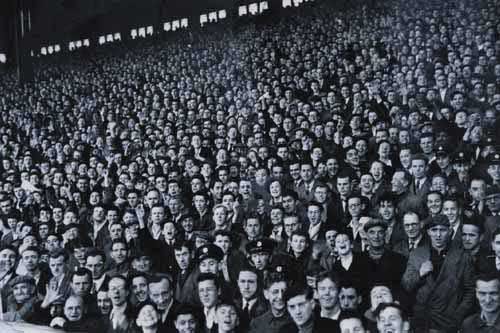WHETHER you like it or not, the debate about rail seating at English football grounds is happening and happening now, writes MATTHEW CRIST. But will it really deliver everything we are lead to believe and just who, if any, will benefit?
Since the introduction of all-seater stadiums in the early ‘90s following the Hillsborough disaster, football supporters across the UK have debated whether you should be allowed to stand at football.
More recently, however, there seems to have been something of a ground swell of opinion in favour of such a change, mostly against a backdrop of rising ticket prices, accusations of fans being priced out of the game and dissenting voices constantly questioning the lack of atmosphere at top-flight matches.
When Celtic introduced a safe-standing section at Parkhead in the summer of 2016 the eyes of the football supporters up and down the country descended on Glasgow’s East End to see just how it worked. Not surprisingly to anyone who is in favour of the system or has looked into how it works, it’s been heralded as a huge success.
As a result the Football Supporters’ Federation has recently contacted each English Premier League club to canvas the opinion of their supporters on rail seating while West Brom have made it clear that they would be more than happy to put their name to a pilot scheme; and word is they are not the only ones interested.
Meanwhile, in July, League One Shrewsbury Town applied to become the first club in the country to introduce standing sections at their New Meadow stadium after close consultation with supporters groups, with Northampton Town looking to follow suit.
But perhaps the most telling move has come in the form of the recent Spirit of Shankly consultation meeting, which allowed Liverpool fans the opportunity to discuss their views on a return to standing — a subject which is more sensitive on Merseyside than anywhere else.
Whereas a decade ago the mere suggestion of a return to standing at football would have been depicted in the media by shots of crumbling terraces of the ‘60s and ‘70s and usually featuring images of rampaging hooligans just for good measure, there now seems to be a general understanding that rail seating could perhaps be the compromise that fans and clubs have been searching for.
Good news for anyone who feels that standing is part of football culture and still has a place in the modern era, along with those who feel they have been lost to today’s cash-rich, made-for-TV sport, who see a shift in opinion towards rail seats as a positive and a way to reconnect with the game once again.
But what guarantees do we have that any of this will actually happen?
These days, rather than being met with horror stories about an increase in hooliganism and a return to “the dark ages”, listen to a discussion on standing at football now and you’re more than likely to hear points raised about increased capacity, greater fan interaction and cheaper tickets, thanks to the great work done by Jon Darch and the Safe Standing Roadshow among others.
Well, sorry to look at the negatives, but has anyone thought that all the good news surrounding rail seating, every image of 3,000 Celtic fans singing and jumping in unison, each story that filters back from Germany about how great the atmosphere is at football, might actually have the opposite effect?
When Guns N’ Roses played at the former Olympic Stadium in London recently tickets were around the £100 mark, about the norm for such a show these days. That is, of course, unless you wanted to be in the “Golden Circle”, where you have to pay considerably more than that.
That’s because in the “Golden Circle” you are close to the action, with like-minded people where you can dance, stand, sing and have a good time – but as always with good things, that comes at a premium.

ALL CHANGE: The standing Kop and the Kemlyn Road
And it’s not just at Guns N’ Roses gigs that you will see this. Look at any major concert or stadium show and there will be a similar system in place.
Initially brought in to prevent crowd surges and crushes at gigs, which often resulted in scenes akin to what was commonplace at football stadiums several decades ago, a partitioned area at the front of large shows and festivals is now a familiar site.
More recently, however, the much sought after wristbands that allow concert goers entry to what those of us of a certain age would know as a “mosh pit” can change hands at extortionate prices, sometimes even twice or three times what you’d pay in other parts of the arena to watch the same show, such is the desire to be where the action happens.
Although introduced with the best intentions at heart, such a policy can unwittingly create a sense of “them and us” at an event that is meant to be enjoyed by the many and not the few as those outside this section look on with envy and, no doubt, an element of resentment at what they are missing out on.
Of course, at such an early stage we don’t know what an introduction of rail seating might bring with it, but just imagine a Kop that is converted to safely accommodate 10,000 people, all standing up, singing and bouncing. Just what could the club charge for these spaces, or more importantly, what would people be willing to pay?
One of the few positives of the old terrace system was that if people wanted to stand, they stood, if they wanted to sit down they sat. These days we don’t have that choice and there can’t be many of us who haven’t had people yelling at us to “stand up and get behind the lads!” at matches, only for another voice to implore us to “sit down!”
An introduction of safe standing areas will, of course, mean that in theory people will once again have the choice; but only if those places are allocated in the right way and to the right people and not offered as a reward or even worse, some kind of corporate gimmick.
At the moment some supporters remain confused as to whether rail seats would actually increase capacity, as effectively, and often without some major restructuring work, one rail seat would only replace one existing plastic seat at home most Premier League grounds.
This means clubs would only have the same number of places to offer fans, so would they really be willing to offer an improved and more enjoyable experience, that we are so often told safe standing offers, at a reduced price when they know there is such demand?
As yet, clubs have made no comment on what policy they may adopt should standing sections be introduced. Of course they can’t, it’s far too soon. But if it happens, safeguards need to be introduced to ensure that these spaces are available to those who can’t afford to go to games now or simply can’t get tickets, and don’t merely become available to an exclusive club.
At Celtic Park, for example, the designated rail-seating area in what is known as section 111 is allocated to just under 3,000 season ticket holders at a price of around £23 per game, but that doesn’t mean that there aren’t 30,000 other folk looking on, wishing they too could be part of the fun.
It’s a feeling that all match-going fans will sympathise with. We all know how difficult it is to get tickets for away games, because there are such limited spaces available and there is such a desire among match-going fans to experience the atmosphere in an away end at a time when going to home games often just doesn’t cut it anymore.
Until the recent £30 cap on away tickets, away fans would often pay more than any other in the stadium to watch the same game, mostly due to the fact that only the hardcore will go; but obviously this doesn’t change the fact that on the black market an away ticket can still go for hundreds with many willing to pay.
It may be jumping the gun a little but as the debate progresses and the consultation continues let’s hope football clubs are listening and have a contingency plan in place to prevent safe-standing sections, should they be introduced, becoming the “Golden Circle” of English football grounds.
Recent Posts:
[rpfc_recent_posts_from_category meta=”true”]
Pics: David Rawcliffe-Propaganda Photo












Standing at football matches is selfish (and stupid). There are many elderly supporters in the stadium over age 60 who cannot stand for approx. 2 hours. If they sit, then those standing in front of them blocks the view of the elderly who therefore cannot see the match.
I think you’ve absolutely misunderstood what safe standing is. There would be seats too. It would be optional whether you choose the standing area or the seated. Elderly will not go in the standing area to use their seat. Show some common sense mate, please.
The decisions made about safe standing should be left to those who go to the game. Those who know the reality of the current situation. Currently, elderly people are suffering because in big games and when Liverpool are close to scoring everyone stands up. That means elderly have no choice but to stand too. Also, speak to anyone at the Dortmund game (where everyone stood) and you’ll hear stories of injuries because people were standing in front of their seat and fell over the seat in front. The choice seems simple, rigorously enforce seating thereby killing the atmosphere and create flashpoints with people being ejected every 2 mins or introduce safe standing.
An issue that nags away at me when people refer to safe standing as being safe – I’m sure it is, but its only safe for those in that area. Introduce a 3,000 capacity are in a part of the Kop, how does that bring safety to the other 15,000 or so who stand in the remainder of the Kop and the Anfield Road? It feels a small step in when bracketed as a safety improvement.
I think you’ve answered your own question and reiterated the need for safe standing. It doesn’t help the other 15k who stand because they’ll be standing in a seated area. It’s not safe. The safety comes or those in the standing section. Why are the 15k standing in the Kop or Anfield Road (as in your example) in the first place?
This is my point. There need to be enough rail seating spaces to cater for all those who want to stand and be accessible for everyone. Not just a token gesture.
The final answer is for the whole Kop to be standing, or at least 75% with standard seating for those who prefer it in the first 10 rows or so.
Same with Annie Road.
I don’t see how it works otherwise. Not in terms of improving levels of safety.
But we’ll see how it plays out I guess
The other point I think of is if a standing area exists will the remainder be more actively forced to sit?
I think, in an ideal world, if there are enough safe standing spaces, that are available to the people that want them, there won’t be so many people stood in the seated areas. I don’t recall it being such a problem in the ’80s and early ’90s?
That’s the whole reason for the discussion over Rail Seating, Herbie. It should give people the choice whether to sit or stand. The current system obviously isn’t working.
It seems pretty obvious why the debate has gained any attention at all from decision-makers:
The Premier League know that the atmosphere at many grounds is absolute garbage unless something extraordinary is happening. Part of the Premier League’s appeal is that they sell passion and a great atmosphere in sold-out grounds. The Bundesliga, for one, has increasingly marketed this as its USP: Standing terraces, choreographies and songs, and beer at the grounds.
Until recently, it was incumbent upon clubs to draw as much revenue as they could from their ticket sales. Accordingly, the thought of going back to terraces seemed inconceivable. However, the past two tv cycles have shifted the goalposts. Media rights revenue is now so much bigger than any other source of income that it no longer matters whether there are a few empty seats at grounds, whether prices could be a few pounds higher or whether there are enough regular seats being sold. And moreover, the global appeal of the Premier League is now such that they can realistically supplement that revenue with corporate sponsorship deals (now being struck worldwide, and being pursued professionally by all the leading clubs) and commercial activities. The mug punter who turns up to sit behind the goal no longer needs to be bilked out of every last penny. In fact, he wouldn’t even be needed at all, if not for the fact that empty seats make for a bad image on TV. With all of the other riches to be gained, the most important thing for a club to achieve on matchday is a visual image, and an accompanying sound, that is attractive enough to allow it to keep selling a worldwide audience on the idea that anything stamped with a Premier League watermark is an extraordinary event of unparalleled importance.
This is why the Twenty’s Plenty campaign had any success at all: Because enough clubs recognised that it would make perfect sense to accommodate a few away supporters, and ensure the atmosphere they bring with them, given that the price of doing so amounts to a small five-figure cost per match at most. Small potatoes when you’re drawing millions per match in TV money alone, and when you’re upgrading your hospitality facilities and main stands to sell a growing number of tourists and high rollers increasingly expensive tickets marketed as “experiences.”
Nick Hornby had this point down 25 years ago: If there weren’t any terraces to stare at, it would be harder to sell the expensive seats. The clubs have always needed some atmosphere as a selling point – it’s just that only now have they become so stinking rich from other sources that they’re willing to miss out on a few pounds in ticket prices from the punters who provide it.
So with regard to the article: It may be 3,000 spots or it may be that some club decides they need to out-do Dortmund (Tottenham seem to have designed in this direction). It won’t matter either way, because either way it won’t be derived from any decision maker’s conviction about wanting to create a certain type of club through an inclusive stadium design, and it won’t come about because any club actually feels that a terrace, viewed independent of all other factors, is a smarter short-term or long-term business proposition. It will come about because there is an economic benefit, in terms of brand-building and product attractiveness, that justifies sacrificing potential ticket revenue in favour of a certain look, feel and sound to matches. Expect some clubs to be subtle about it and others to be more ham-handed – I could imagine clubs instituting points systems, clubs reserving parts of terraces for tourist supporters to be a part of “the experience”, clubs selling terrace access to sponsors as a special money-can’t-buy experience, and clubs instituting social-engineering-type solutions such as kids-only, youths-only or families-only terraces that are designed to look like something of an old-style crowd. Expect any number of horribly over-engineered solutions, but just don’t expect the new sort of terracing to be anything like the terraces people remember and yearn for.
The pl and sky can easily manage the atmosphere to the global TV audience. Seen many a game where you’d think there were 50,000 there. The match going atmosphere isn’t a concern
Can I ask a possibly dim question about this? I’m old enough to have stood in big stadia. Not Anfield, but the old Hampden Park and other Scottish grounds. Isn’t one of the issues here that the old style terraces could be shallower, because of the fact that everyone was standing, and therefore people were able to interact more easily. Granted, standing of itself makes singing and atmosphere more likely (unless you’re watching Scotland!) but I wonder whether we should think about that too, for example when redeveloping the Anfield Road. If we have standing, should / can the gradient be flatter? Personally, I prefer to sit, and would continue to, but I think it would be positive if we can find a way through this issue. Incidentally, I agree with the contributor above who says that the TV companies can just manufacture atmosphere. But let’s not be too hard on ourselves – I was able to go 8 times last year and the atmosphere was not bad at all, mostly (maybe not first half against Swansea!).
I might be wrong, but I don’t recall grounds rebuilding stands to accommodate seating back in the v early 90s. They simply bolted seats onto the existing terracing in most cases.
Many did start from scratch. That’s if the structure was not deemed strong enough to support the seats; while many clubs saw it as an opportunity to rebuild old structures (do you not remember the large hoardings which were often seen behind the goals at grounds in the early-mid ’90s as stands were rebuilt?) Some new grounds, such as at Tottenham’s stadium, are already being built with Rail Seats in mind for the future, apparently.